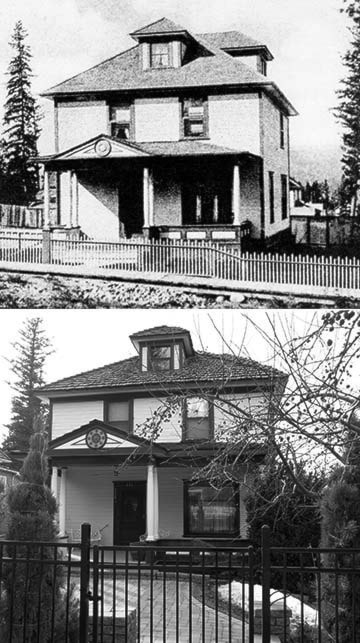Jim Cameron
William Henry Wilson, a jeweler and optician by trade, arrived in town in 1902, at the age of 25.
Born in Farnham, Quebec, it is likely his decision to move to Cranbrook was due to the presence here of his first cousin Samuel Hungerford, a local CPR locomotive shop foreman.
W.H. Wilson was not the first jeweler in the city, indeed he came in about fourth on the list although two had come and gone, but Cranbrook was a booming town and there was room for duplication. Thus, W.H. Wilson Jeweler happily settled in to ply his trade. He opened his first store on Armstrong (9th) Avenue in June 1902. The jewelry trade proved profitable but it was his skill as an optician in which he truly excelled.
A man of energy and ambition, it was not long until he married Miss Emily Amelia Johnson of Knowlton, Quebec, in a quiet wedding at the Cranbrook Methodist Church and rented a larger storefront on Baker Street to increase the visibility of his business. He would move again within a year to a spot on the opposite side of the street near the Manitoba Hotel (now demolished).
Ever the modern man, Christmas of 1902, saw his large plate glass display windows declared amongst the finest in the Kootenays, not just for the contents but for the very impressive electrical revolving display that captivated shoppers.
Business increased and in June, 1904, he hired Thomas McKee as watch repairmen while he himself set up rooms in the rear of the building dedicated to the optical trade. He took a very active part in civic affairs, a practice he was to continue throughout his life. He joined the city band, developed a serious interest in automobiles, donated trophies (which he engraved using the most up-to-date equipment) to any and all sporting events and generally became a stalwart of the community
His stock grew as he added to his collection of fine jewelry, silverware, cut glass, diamond rings, gold cuff links, gents' chains, ladies lorgnettes, sterling silver and flatware and clocks and watches of all types. His stock dwindled as his assistant Mr. McKee regularly pilfered a large degree of inventory, much of which made its way to the red-light district as gifts for the ladies whom Mr. McKee swore he was trying to "lead to Jesus." The path eventually led to a five-month jail sentence in Nelson where he spent time with Charles Delaney, who was arrested trying to rob Wilson's Jewelry with the use of a piece of hay wire through a hole drilled in the display window casement while cleverly disguised in black greasepaint. Mr. Delaney received a one year sentence.
In August, 1906, construction began on the Wilson residence, one of the finer homes of the area at the time, a mantle it carries to the present day. The well-crafted lines of the two-story structure are highlighted by a verandah featuring a triangular pediment into which is set a unique decorative medallion. Until recently it was one of the last homes in the Baker Hill district to retain its original picket fence (or any picket fence for that matter).
Mr. and Mrs. Wilson moved into their new home in October, 1906, and added their only child, daughter Jean, one year later. William's sister May, a nurse, also joined the family. Sept. 1907, saw the jewelry store move to its final location in the former Bank of Commerce on Baker Street, near the present day clock tower.
The Wilson's travelled back east frequently, not only to visit family but to allow Mr. Wilson to further his optician's education, allowing him to eventually grind his own lenses as part of his services. He travelled to the St. Louis World Fair in 1904 and found himself in New York City in 1909 to witness the famous flight of Wilbur Wright around the Statue of Liberty. On a more local note he is credited as having driven the first automobile from Cranbrook to Moyie and Yahk, a feat which, given the roads (or lack of) at the time, placed him among the upper echelons of automobilists of the day.
His ability to captivate window shoppers came once again to the fore in 1911 when he introduced a novel device; an electric projector which, through the use of a strong light bulb, two powerful lenses and glass advertising disks, allowed him to project advertisements as far as 30 feet, although he mostly confined them to the sidewalk in front of his shop, to the great delight of passersby.
Mr. Wilson retired in 1939, selling his building, one of the very first constructed in the city, to Aris Catsirellis who demolished it and constructed a brick edifice that became the Pat Coffee Shop many years and was, in turn, eventually demolished by the City of Cranbrook. William Henry Wilson became Cranbrook's first "Good Citizen of the Year" in 1953, in honour of his many years of contributions to civic causes. He died at the St. Eugene Hospital on Jan. 17, 1958, having outlived his wife by two years.
Endnotes: W.H. Wilson's sister married A.H. Eager, after whom nearby Eager Hill is named. His first cousin Samuel J. Hungerford went on to become president of the Canadian National Railways and Trans-Canada Airlines.
In memory of ManWoman 1938 - 2012
